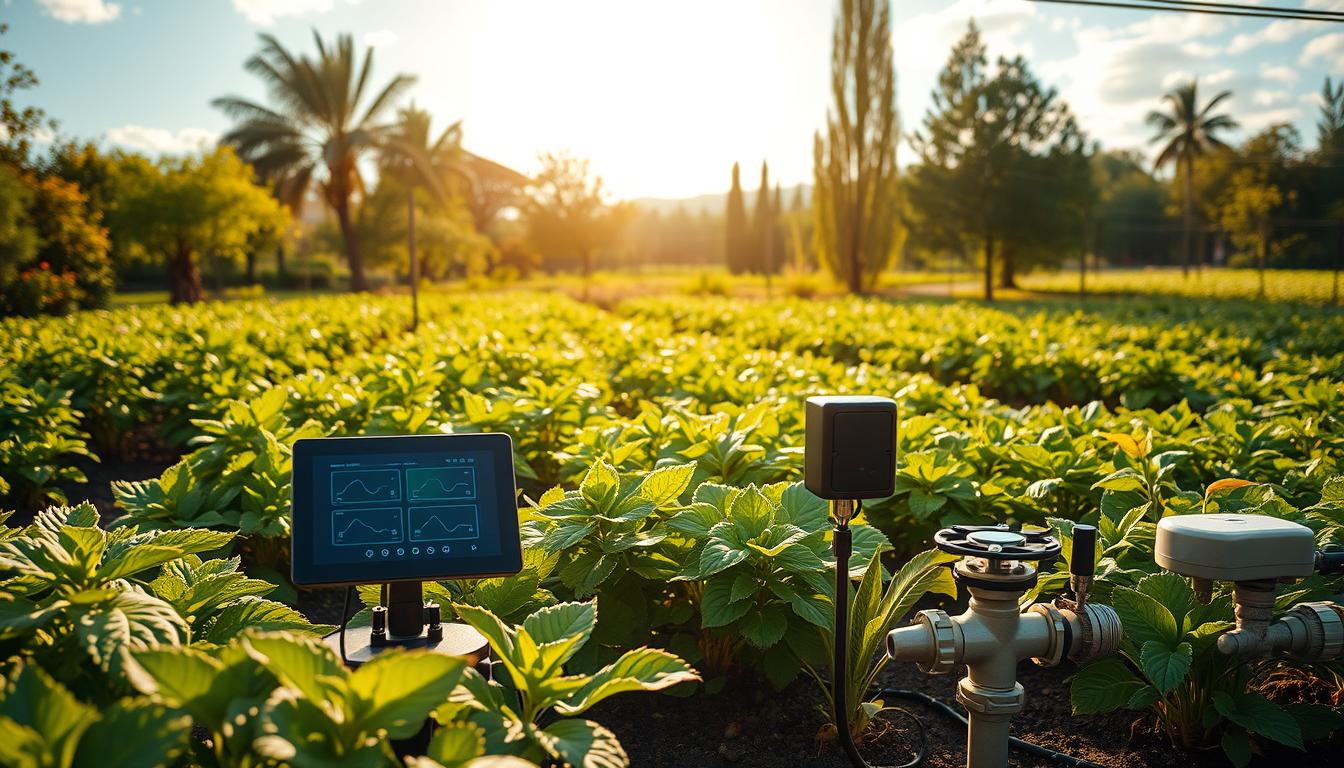Remember when taking care of plants meant strict watering schedules and constant watching? Those days are quickly fading as smart technology changes our green spaces. Now, garden automation systems do the hard work, giving busy people and plant lovers more freedom and better results.
The rise of automated plant care solutions is a big change in how Americans grow plants. These innovations bring precision that humans can’t match – from sensing soil moisture to controlling the climate. A single smart controller can manage watering for dozens of plants, adjusting based on weather and actual conditions.
The benefits go beyond just being convenient. Smart gardening saves water with targeted irrigation, cuts down on fertilizer waste with precise application, and creates perfect growing conditions for healthier plants. For new gardeners, these tools take away the scary guesswork. They give experienced growers data-driven insights to improve their techniques.
As we dive into horticultural technology, you’ll see how these innovations make growing more accessible, sustainable, and rewarding for everyone. This is true whether you’re new to gardening or have lots of experience.
The Digital Revolution in American Backyards
The digital age has reached our gardens, changing how we care for them. Homeowners are using smart technology to make gardening easier. This change is more than just a new trend—it’s transforming our outdoor spaces.
Recent surveys show over 35% of homeowners use garden automation. This is most common in dry Western states and tech-savvy cities. The market for these systems has grown by 24% each year since 2020.
How Technology is Transforming Home Gardening
Today, garden technology ranges from simple to complex. Basic systems include programmable irrigation and soil moisture sensors. These tools help with watering schedules.
Advanced systems monitor weather, soil, and plant types. Smart sprinklers adjust watering based on these factors. Soil sensors check moisture, pH, and nutrients in real-time. Some systems even have robotic weeders and mowers.
| Traditional Gardening | Automated Gardening | Benefits of Automation |
|---|---|---|
| Manual watering based on observation | Sensor-driven irrigation systems | 30-50% water savings |
| Weekend weeding sessions | Robotic weeders | 85% reduction in weeding time |
| Seasonal planting guesswork | Climate monitoring systems | Increased plant survival rates |
| Manual fertilization schedules | Automated nutrient delivery | Optimized plant growth |
The Shift from Weekend Chores to Smart Cultivation
Gardening has become a fun hobby for many. Mark Ramirez from Phoenix says his automated irrigation saved his garden while he was away. Before, he’d return to dead plants.
These technologies aren’t just for tech fans. Linda Johnson from Michigan uses a simple soil monitoring system. It alerts her phone when plants need care. “It’s given me confidence to grow more challenging plants,” she says.
The beauty of garden automation is not replacing humans. It handles the hard parts, letting gardeners enjoy the creative aspects. Technology boosts gardening success and reduces work.
Garden Automation Systems: The Complete Overview
Today’s garden automation systems change gardening into a modern, data-driven activity. They help plants grow better and save time. These systems use devices and software to monitor and adjust conditions, making gardening easier.
Defining Modern Garden Tech Ecosystems
A garden tech ecosystem is a network of devices and apps that work together. They automate plant care, unlike single gadgets. This network makes smart decisions based on real-time data and history.
The core of any garden automation system includes sensors, controllers, and actuators. Smart controllers manage data and actions. Sensors check soil moisture, temperature, light, and humidity.
Actuators carry out commands, like opening valves or adjusting vents. You’ll find automated irrigation, robotic mowers, and plant feeders in these systems.
Software and Connectivity Options
Smart software is the brain of garden automation. It analyzes data and controls hardware. Mobile apps let you monitor and adjust settings from anywhere. Cloud platforms store data for pattern recognition and maintenance.
Devices talk to each other through various connections. Wi-Fi offers wide coverage but uses more power. Bluetooth is good for short distances. Zigbee and Z-Wave are low power and mesh networking.
Integration Possibilities for American Homes
Garden automation fits any American home, big or small. Choose components that meet your needs and fit your home.
Many systems work with popular smart home platforms. This lets you control your garden with voice commands or as part of home routines.
| Property Type | Recommended System Scale | Key Components | Integration Complexity |
|---|---|---|---|
| Urban Apartment | Micro-system | Smart planters, LED grow lights, compact sensors | Low – typically Wi-Fi based |
| Suburban Home | Medium-scale system | Irrigation controllers, soil sensors, weather stations | Medium – may require hub installation |
| Rural Property | Comprehensive system | Multiple zone controllers, robotic equipment, remote monitoring | High – often requires professional setup |
| Community Garden | Shared system | Multi-user access, zone-specific controls, notification systems | Medium-high – needs user permission management |
Scalability is a big plus of IoT gardening solutions. Start small and add more as you grow. This approach makes automation easy, no matter your skill level or budget.
Why Automated Gardening Makes Sense for Busy Americans
Garden automation technology is changing the game for busy Americans who love gardening. They often find it hard to keep up with plant care due to work and family. But they still want beautiful, productive gardens. Automated systems help by taking care of routine tasks, keeping the joy of gardening alive.
Reclaiming Your Weekends: The Time-Saving Advantage
Traditional gardening can take 5-10 hours a week. But with automated systems, it’s down to just 1-2 hours of checking and adjusting.
“I used to spend every Saturday morning watering, weeding, and fertilizing,” says Michael Reeves, a Seattle software developer. “Now, my automated system takes care of it, and I only need to check in sometimes. We’ve got our weekends back.”
For Sophia Chen, a marketing executive who travels a lot, automated plant care has been a game-changer. “Before, I’d come home to wilted veggies and dry flowers. Now, my garden stays healthy whether I’m there or not.”
Resource Conservation in an Era of Climate Concern
Smart garden systems save time and resources. They use 20-50% less water than manual watering by giving just the right amount when needed.
Soil moisture sensors stop overwatering, and weather-responsive controllers adjust watering based on weather. This also means using up to 30% less fertilizer while keeping plants healthy.
These systems help with water and fertilizer, which is good for the environment. Many homeowners see this as a positive step towards conservation.
Achieving Consistent Results Year-Round
Garden automation brings consistent care to your plants. Humans forget, get busy, or misjudge plant needs. But automated systems don’t.
“The difference in my garden’s productivity has been amazing,” says retired teacher Barbara Wilson from Arizona. “My automated drip system and soil monitors keep perfect conditions, even in our hot summers.”
This consistency works all year, adjusting to changing conditions automatically. It helps new gardeners feel confident and succeed. For experienced gardeners, it lets them focus on design and plant selection.
Smart Irrigation Controllers: Water Management for Drought-Prone Regions
In areas where water is scarce, smart irrigation controllers are key for keeping gardens beautiful. They use technology to manage water better than old systems. This is good for the environment and your garden.
Popular US Models and Their Capabilities
The US market has many smart irrigation controllers. Each one has special features for different needs and budgets.
Rachio controllers are known for their easy-to-use apps and weather integration. They even have flow meters to find leaks fast, saving gallons of water. Orbit B-hyve offers affordable options without losing important features, making smart irrigation more accessible.
Hunter’s Hydrawise is great for complex gardens, with up to 54 zones. RainMachine focuses on privacy, using local weather without needing the cloud.
| Controller Brand | Price Range | Max Zones | Special Features | Weather Data Source |
|---|---|---|---|---|
| Rachio 3 | $149-$279 | 8-16 | Flow meter compatibility, leak detection | NOAA, Weather Intelligence Plus |
| Orbit B-hyve | $99-$199 | 6-12 | WeatherSense technology, budget-friendly | AccuWeather |
| Hunter Hydrawise | $179-$299 | 6-54 | Professional-grade, flow monitoring | Global weather stations |
| RainMachine | $169-$249 | 8-16 | Local weather processing, enhanced privacy | NOAA, local radar |
Setting Up Zone-Based Watering Schedules
Smart irrigation shines with zone-based scheduling. It’s about knowing your garden’s unique needs. Different plants need different care, and some areas get more sun than others.
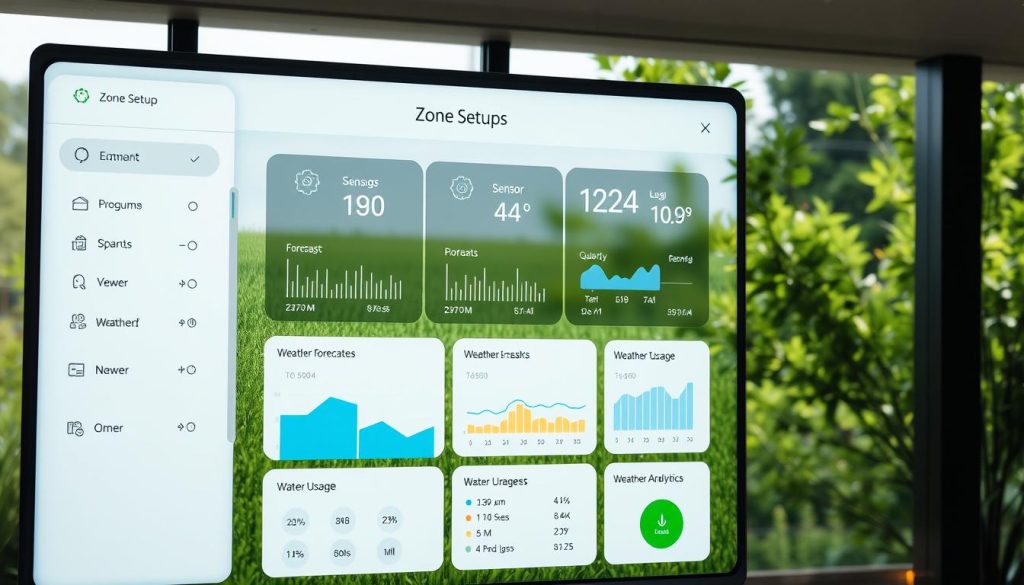
Group plants by their water needs. Vegetables might need more water than native plants. Most controllers let you set up zones based on soil, sun, and plant type. This way, you get a watering plan that’s just right for your garden.
Adapting to Local Water Restrictions
States like California and Texas have strict watering rules. Smart controllers help follow these rules. They can be set to water only when allowed, avoiding fines and keeping your garden healthy.
Some models even connect to local water districts. This means they adjust to changing rules without needing updates. This is super helpful during droughts when rules can change fast.
Integration with Weather Services
Smart irrigation controllers are amazing at adjusting to the weather. They connect to local weather services to skip watering when it rains. This saves water and keeps your garden healthy.
The best controllers do more than just check for rain. They look at evapotranspiration rates, considering temperature, humidity, wind, and sun. This ensures your plants get the right amount of water, not just based on a schedule.
Garden Sensors: Your Plants’ Voice in the Digital World
Modern garden sensors are like smart translators. They turn your plants’ silent signals into digital info you can understand. These IoT gardening solutions make gardening easier, not harder. No more guessing if your plants need water or fertilizer.
Essential Monitoring Parameters for American Growing Zones
Different parts of America have unique gardening challenges. Garden sensors can be set up to meet these needs. They track important factors like soil moisture, temperature, and light for your plants’ health.
- Soil moisture levels – crucial in dry areas
- Temperature fluctuations – key for cold climates
- Light exposure – important for shaded gardens
- Humidity – vital for humid areas
- Soil pH and nutrient content – essential for all crops
Interpreting Data for Actionable Insights
Garden sensors do more than just collect data. They turn that info into useful gardening tips. They compare your readings to what’s best for your plants and local weather, then suggest actions.
Mobile Apps and Notifications
Today’s garden sensors work with smartphone apps. These apps show your garden’s health in easy-to-read dashboards. They send alerts when your plants need attention, like when it’s too cold or dry.
You can set up these apps to only alert you when it’s really important. This keeps you from getting too many unnecessary messages.
Seasonal Adjustments for Optimal Growth
Garden sensors are great for handling seasonal changes. They help you adjust watering, protection, and fertilizing as the seasons change.
- Spring: Check soil temperature for planting
- Summer: Watch evaporation to water right
- Fall: Warn of frost and harvest time
- Winter: Keep an eye on indoor plants
These sensors don’t replace the joy of gardening. They help you learn more about plants. Many gardeners say using sensors has made them more connected to their plants.
Horticulture Robotics: Mechanical Helpers for Modern Gardeners
Modern gardeners are turning to horticulture robotics for help. These robots take on the hard work of gardening, freeing up time for fun. They do everything from mowing lawns to pulling weeds, changing how we garden.
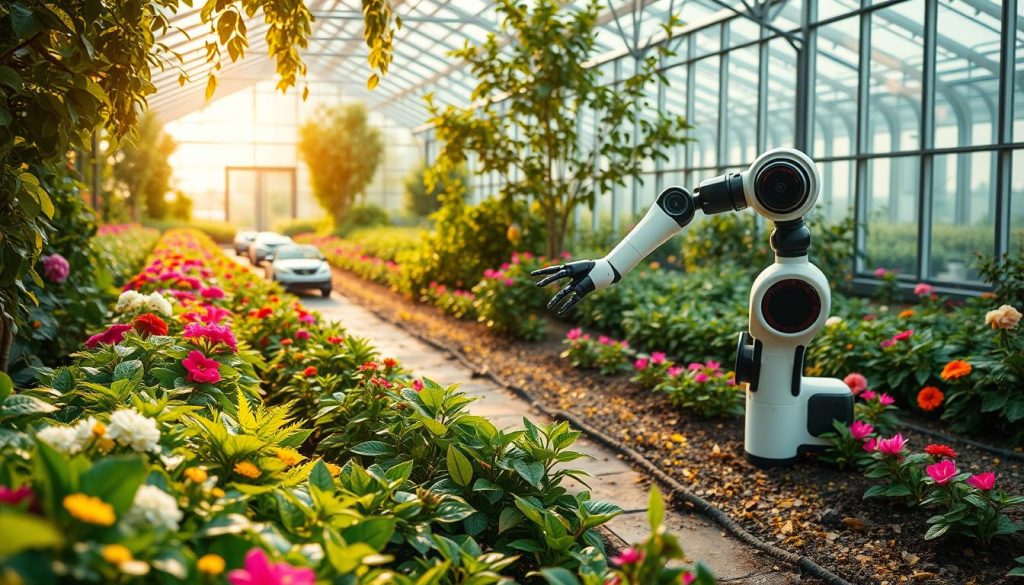
Automated Mowing and Maintenance Solutions
Robotic lawn mowers are leading the way. The Husqvarna Automower series is top-notch, navigating complex lawns with ease. WORX Landroid models offer affordable options with cool smartphone app features.
Robomow units are great for big lawns, cutting well and returning to charge when needed. They need a boundary wire at first but then work on their own schedule.
Other robots are also making a splash. Automated gutter cleaners keep water flowing right, and robotic pool cleaners help keep water systems healthy.
Weeding and Harvesting Assistants
Tertill robots are perfect for weeding, using sensors to spot weeds. They’re solar-powered and patrol gardens daily, keeping them weed-free.
Harvesting robots are getting better too. They can tell when fruits are ripe, though they’re not common yet. They work best with crops like tomatoes and strawberries.
Practical Experiences from American Users
Florida’s Michael Reeves loves his robotic mower. “It keeps the lawn looking great without me getting hot,” he says. “Setting it up took a weekend, but I haven’t used a regular mower in two years.”
Sarah Whitman from Oregon has mixed feelings. “Our Tertill weeding robot is great for veggies, but not for wildflowers,” she notes. This shows how important it is to choose the right robot for your garden.
James Chen from suburban Chicago likes the consistency. “My automated systems keep the garden looking good, so I can focus on the fun parts of gardening.”
Greenhouse Automation for Extended Growing Seasons
Technology and greenhouse gardening have opened new doors for growing plants all year. Greenhouse automation turns simple spaces into smart ones that adjust to changes on their own. This lets gardeners in Minnesota grow tomatoes in January and those in Arizona keep greens cool in the summer.
Climate Control Systems for Variable US Weather
Modern climate control systems are the brains of automated greenhouses. They watch and adjust many factors at once. These smart systems keep the perfect growing conditions, no matter the weather outside.
The best climate control for gardeners includes:
- Smart thermostats that turn on heating or cooling when needed
- Programmable lighting that matches the seasons
- Soil moisture monitors that control watering
- Weather-responsive controllers that predict changes
Many systems now connect to smartphones. This lets gardeners check and adjust things from anywhere. It’s super helpful during bad weather or when they’re away.
Automated Ventilation and Humidity Management
Good airflow and moisture are key for healthy plants and preventing disease. Automated systems handle these important tasks.
In the cold months, automation really shows its worth. Grow lights provide extra light when it’s dark, and heaters keep it warm. Thermal mass controllers slowly release warmth at night, keeping plants safe.
Summer Heat Mitigation Techniques
Summer brings its own set of challenges. Automation helps by using shade cloths to block too much sun. Misting systems cool things down when it gets too hot. Smart fans also help by bringing in fresh air and keeping it cool.
With these automated tools, gardeners can grow plants all year, no matter where they are. The tech adjusts to the seasons and unexpected weather, giving plants the care they need every day.
Space-Efficient Solutions: Vertical Farming and Hydroponics
Modern gardening has evolved with automation, making it possible in small spaces. For those in cities, gardening seemed out of reach due to lack of space. But now, vertical farming and hydroponics are changing this, turning tiny spots into gardens.
Urban Gardening Automation for Limited Spaces
Automated vertical farming systems are a game-changer for city folks with little room. These systems turn walls into gardens, using sensors and automated watering. They can even adjust light and water for each plant.
These systems stack plants to make the most of space. Each level gets the right amount of light and water. This ensures all plants grow well, no matter their height.
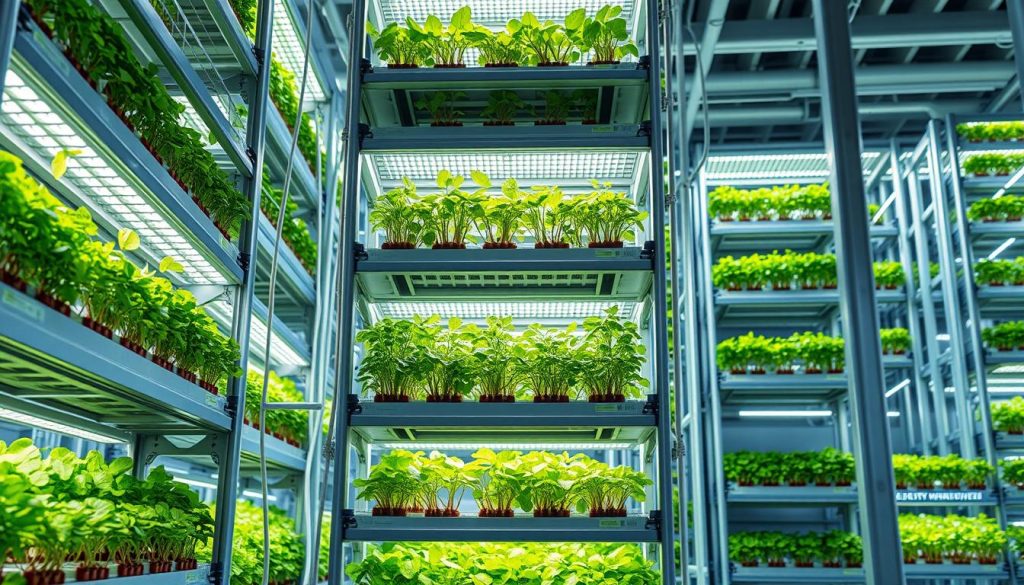
Tower gardens are another smart way to garden in small areas. They can grow dozens of plants in a tiny space. These towers use water and nutrients from a reservoir, making gardening easy.
Nutrient Delivery Systems and Monitoring
At the heart of efficient gardening are automated nutrient systems. Hydroponics delivers nutrients directly to roots, skipping soil. This tech keeps nutrients balanced, making gardening easier.
Systems like AeroGarden and Tower Garden make this tech easy for beginners. They control everything from lighting to water, making gardening simple. DIY setups also offer a hands-on way to garden, with smart tech to help.
Success Stories from American Apartment Dwellers
Sarah Chen, a Chicago software developer, turned her living room into a garden. She uses a vertical hydroponic system, growing fresh food in just two feet of space. The system takes care of everything, sending alerts when needed.
In Brooklyn, Michael Rodriguez grows food in his apartment using a Tower Garden. He used to kill plants, but now harvests five pounds of produce monthly. The system does all the work, except for picking the food.
Jamie Wilson in Denver grows microgreens and herbs in her closet. Her DIY system keeps conditions perfect, giving her fresh produce every week. She saves money and offers better food to her customers.
These stories show how tech is making gardening possible in small spaces. People in cities are now growing their own food, even in tiny spots.
The Smart Garden Ecosystem: IoT and AI Applications
Today’s gardens use IoT and AI to become smarter. They learn from your garden’s needs and improve over time. This means your garden can take care of itself and get better.
Popular Smart Garden Platforms in the US Market
In the US, many smart garden platforms are available. They use sensors, controllers, and AI to work together. These platforms are like the brain of your garden, controlling everything.
The Gardena Smart System connects many devices like irrigation and mowers. It adjusts watering based on the weather, saving water when it rains.
Scotts Gro focuses on water management with smart sensors. It’s easy to use and affordable, perfect for beginners.
The Edyn Garden Sensor gives detailed info on your garden. It offers care tips for your plants based on real-time data.
| Platform | Key Features | Price Range | Best For | Smart Home Compatibility |
|---|---|---|---|---|
| Gardena Smart System | Comprehensive ecosystem, weather adaptation, robotic mowing | $200-$1,500 | Large gardens, tech enthusiasts | Alexa, Apple HomeKit |
| Scotts Gro | Water management, simple setup, affordable sensors | $100-$300 | Beginners, budget-conscious gardeners | Alexa, Google Assistant |
| Edyn Garden | Detailed analytics, plant-specific recommendations | $130-$400 | Data-driven gardeners, specialty plants | IFTTT, limited voice control |
| Rachio | Advanced irrigation, weather intelligence | $150-$280 | Water conservation, lawn care | Alexa, Google, Apple HomeKit |
Voice Assistant Integration and Smart Home Compatibility
Today’s garden tech is part of the smart home world. This lets you control your garden with voice commands or apps.
Voice commands change how we talk to our gardens. With Alexa, you can say, “Alexa, water the vegetable garden for 10 minutes.” Google Home works the same way.
You can set up complex routines with voice commands. For example, “Alexa, prepare for vacation mode” can do many things while you’re away.
Smartphone Apps for Remote Management
Smartphone apps are key for managing your garden. They’ve become more than just remote controls. They offer detailed monitoring and alerts.
Top garden apps show real-time data and trends. They alert you to problems and let you share tips with other gardeners.
These apps are easy to use, even for those who aren’t tech-savvy. They have setup guides and simple interfaces to help you get started.
Budget Considerations: From Entry-Level to High-End Systems
Before you start using smart technology in your garden, it’s important to know the costs. Whether you have a small budget or want to spend more, there’s a system for you. These systems can make your garden smarter and more efficient.
Cost Analysis for Different Automation Levels
Basic garden automation systems cost between $50-$100. They have timers and simple sensors to help with watering and soil moisture. These are great for saving water and keeping plants healthy without spending a lot.
Systems in the middle range, costing $200-$500, offer more features. They include smart controllers, weather adjustments, and can connect to your phone. These options give you better control and are still affordable.
For the most advanced systems, expect to spend over $1,000. These include advanced sensors, pest control, and nutrient delivery for hydroponics. They offer the most automation but are the priciest option.
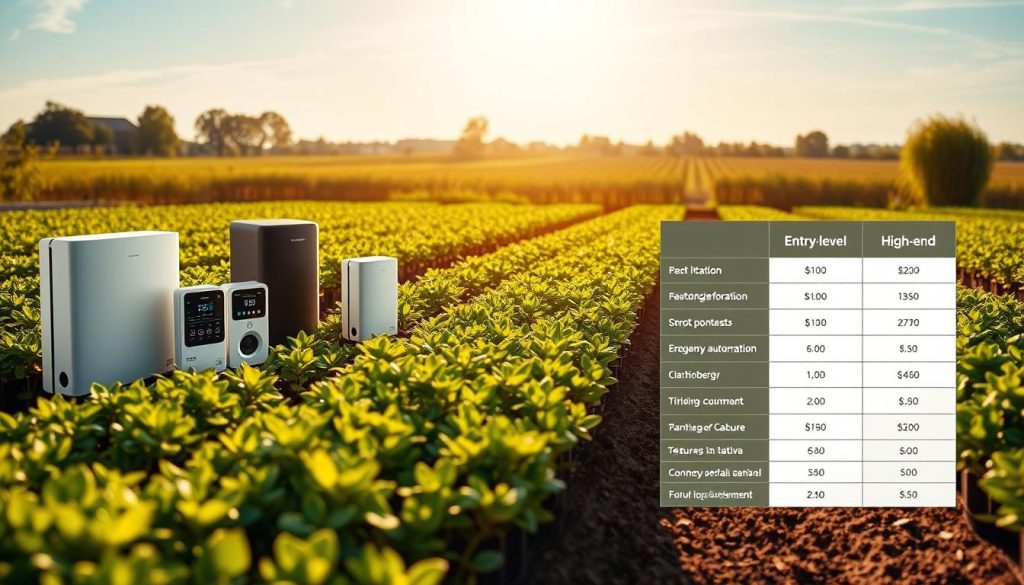
DIY Automation Projects for the Tech-Savvy Gardener
If you’re good with technology, you can make your own automation system. Platforms like Arduino and Raspberry Pi can help. They cost between $25-$55 and let you create custom solutions.
DIY projects can be as simple as automated watering systems or as complex as environmental monitoring stations. You can even build hydroponic systems. Online resources provide guides and support to help you.
Building your own system can be challenging, but it’s rewarding. You save money and learn a lot in the process.
Return on Investment: Calculating Long-Term Value
Garden automation systems can save you money over time. Smart irrigation systems can cut water use by 20-50%. This can save you $100-$300 a year.
Automated gardens also have fewer plant losses and higher yields. Hydroponics can increase productivity by 25-60% and use much less water. These benefits add up to significant savings.
Time savings are another big plus. Automation can cut garden maintenance by 5-10 hours a month. This can save you $100-$200 if you hire gardeners. Even the most expensive systems can pay off in 2-3 years.
The Future of Gardening is Now: Embracing Automation
Garden automation systems have changed from luxury items to everyday tools. They now help gardeners of all budgets and styles in American homes.
These systems save you weekend hours and keep your plants healthy. Smart irrigation can reduce water use by 30-50% in dry areas. This makes automation good for the planet and your wallet.
Don’t feel like going all in? Start with something simple. A basic soil moisture sensor or a simple timer can show you the benefits. As you get more comfortable, you can add more to your system.
New tech is coming fast. AI garden assistants can spot plant diseases from phone photos. Advanced systems adjust care based on weather and plant needs.
Automation isn’t about taking away from gardening. It’s about freeing you to enjoy the creative parts. The tech handles the routine, so you can stay connected to nature.
Automation is for everyone. Busy professionals, retirees, and city dwellers can all benefit. It makes gardening easier and more enjoyable. The future of gardening is here, in your backyard.

